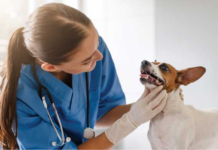Summer in California is here in the Inland Empire, a Southern stretch of the state that’s become a hub of warehousing, packaging, and shipping. Outside the hulking warehouses that line the area’s freeways, a steady rumble of trucks contributes to poor air quality and constant noise pollution in surrounding communities of color. Meanwhile, an army of laborers unloads trucks, palletizes products, packs individual orders, and criss-crosses warehouse floors, most under the oppressive heat of large, poorly-ventilated spaces that can feel “suffocating,” says Victor Ramirez, who has been working in warehouses for 20 years.
“It feels very bad working in the warehouse when it gets hot,” he says in Spanish, through a translator. “The hot air gets stuck, and having to drive the equipment or be around it, it gets really hot.”
Sweating, head pounding, Ramirez operates heavy equipment to ensure that pallets of goods flow steadily through a facility delivering products to Costco and Sam’s Club. He’s working under the constant pressure of quotas, aware that supervisory eyes are on him every time he takes a break to get some water.
Approximately 1.7 million people nationwide work in warehouses like Ramirez. Some 160,000 of those workers are in California, working in what California’s Division of Occupational Safety and Health, or Cal/OSHA, terms a “high hazard” industry.
In the Inland Empire, the increased emissions caused by the warehouse industry are a direct contributor to climate change, as is the built environment more broadly, which creates a heat island effect that raises temperatures even more.
Like Ramirez, most workers dread summers, especially as climate change is increasing the number of high-temperature days. This year, that dread is tinged with frustration: Eight years after the legislature directed Cal/OSHA to establish an indoor heat standard to protect workers like Ramirez from hot working conditions by 2019, the agency finally created a regulation that was almost immediately derailed by protests from another state agency, the California Department of Corrections and Rehabilitation. It, along with the state’s Department of Finance and industries that could be affected by heat protections for indoor workers, claimed the standard would be too costly, despite a commissioned RAND study finding that “the anticipated benefits of the proposed regulation, primarily improvements in worker health and productivity, exceed the anticipated costs.” On June 20—the first day of summer—the agency finally passed a modified version to address these objections by exempting prisons from the regulation. It could go into effect as early as August if state regulators agree to fast-track it.
With momentum on indoor heat protections for most workers finally being realized, Ramirez, among others, will be keeping a close eye on Cal/OSHA to see if the agency makes good on its promise to regulate temperature exposure inside the prison system. Heat is hazardous for not just carceral workers, but incarcerated workers—who are not necessarily covered by Cal/OSHA in the first place, explains AnaStacia Nicol Wright, policy manager at worker advocacy organization Worksafe. Wright notes that all incarcerated people, including workers, often swelter in conditions that can be horrific in high heat. Of Cal/OSHA’s regulatory exemption for prisons, Wright adds, “it always does beg that question of racism and incarceration.”
Nevertheless, California worker-organizers and groups that have been steadily advocating for indoor heat standards and are looking to this landmark moment in heat regulation as a sign of hope. Worksafe is one such group, which has been advocating with workers on a heat protection campaign since 2018 with testimony and written submissions at state hearings and played an important role in organizing around the state’s development and implementation of a standard. The worker-led Warehouse Worker Resource Center, which engages in education and worker actions, is another example, along with Inland Empire Amazon Workers United and the California Labor Federation.
Setting Standards
Indoor heat standards create a framework for regulating workplaces that get dangerously hot, including warehouses, commercial kitchens, and the bowels of sprawling parking structures. Heat illness can cause severe symptoms, including critically high body temperatures and unconsciousness. Repeat heat exposures can be especially risky and may cause problems such as permanent kidney injury.
At least 436 indoor and outdoor workers nationwide died because of high heat between 2011 and 2023. Those deaths are likely an undercount: Cal/OSHA as well as its federal counterpart depend on companies to report these fatalities, and a 2021 NPR investigation observed that Cal/OSHA’s recordkeeping on the subject was “poor.”
Higher temperatures are also associated with a greater risk of workplace accidents. For overall health and safety, it’s critical to protect workers with basic safety measures, including proper ventilation, access to cool water and places to recover from heat, and rest breaks. In the absence of a federal standard on heat for indoor or outdoor workers, only Oregon and Minnesota provide guidance for indoor workers. Washington, Oregon, and California have extended protections to outdoor workers, but some states actually go in the opposite direction. Florida just passed a law blocking local governments from setting their own heat standards, for example, following a growing GOP trend to pass state-level preemption laws that block more liberal municipalities and counties from passing ordinances and regulations related to labor, police funding, and gun control, among other issues.
A national standard would address these issues, protecting workers in every state, argued lawmakers to the U.S. Department of Labor in 2023. And in 2021, the Biden Administration promised action on this issue. The Department of Labor is still going through the rulemaking process required to issue a federal heat standard, and depending on the outcome of the presidential election in November, a federal standard may not happen at all.
Without formal heat regulation, it can be challenging to hold employers accountable for dangerous conditions, as seen in San Bernardino in July 2023 when Cal/OSHA inspectors were unable to cite an Amazon warehouse for high indoor heat.
“These are jobs we go to [in order to] make a living. Nobody should be dying at work. Who wants to go to work and die? Of all the ways you could die, to die at your employer because you were trying to make a living and they couldn’t be bothered to make sure you were safe…” says Worksafe’s Wright, her voice trailing off as she reflects on the suffering across California’s sweltering indoor workplaces.
“For folks who might not know, particularly in the Inland Empire, it’s very hot,” says Tim Shadix of the Warehouse Worker Resource Center. “In the worst warehouses there’s not good climate control or air conditioning. It can get as hot or hotter inside as the temperature outside. In the Inland Empire that’s easily in the 90s or triple digits.” The Southern California Association of Governments notes that the number of extreme heat days—with a heat index above 90 degrees—in some areas of the region could hit as many as 43 per year between 2040 and 2060.
California’s regulation will require access to drinking water and cool places to recover from heat exposures when indoor temperatures rise above 82 degrees Fahrenheit. Workers wearing restrictive clothing (such as PPE) or working in areas with radiant heat, such as the equipment Ramirez works with, would be entitled to more protections. At 87 degrees or higher, workplaces would also be required to use “engineering controls” (such as ventilation) to lower and control temperatures. Worksafe joins experts in arguing that protections should kick in at 75 degrees, or around 71 degrees for workers doing moderate and heavy labor.
“The temperatures are high if we’re just sitting out and having lunch with our family, and high if we’re at the beach,” UPS employee Robert Moreno told the Department of Industrial Relations at a May 2023 hearing. “But now think about these temperatures inside of a warehouse that’s been sitting in the sun all day long. Most of these warehouses are sheet metal—sun radiates inside all day long. You go into these warehouses, there’s zero to no airflow, very [stifling] heat.”
Outdoor Heat
Indoor workers aren’t the only ones wilting in the heat. Poor conditions for outdoor workers, especially farmworkers, are a perennial theme of hot summers. California was actually an early trendsetter in adopting an outdoor heat standard in 2005, which mandates access to clean drinking water and requires shaded places to rest when outdoor temperatures exceed 80 degrees. Employers are also required to allow agricultural workers a 10-minute cooldown period at a minimum of every two hours when temperatures soar above 95.
Temperatures are not the only concern, as seen in 2020 when farms took advantage of their “ag pass” to keep workers onsite in the midst of wildfire evacuations, and again this June when agricultural workers were once again “allowed” to enter areas under evacuation to work. Those workers were sent out even when the air was choked with ash and particulates from wildfires with the express goal of bringing in crops before they were smoke-tainted.
California requires employers to “offer” N-95 masks and other PPE on days with poor air quality, but workers say that requirement isn’t necessarily honored, and some may not even be aware of this entitlement. And a more robust version of that bill would have included “strike team” workplace enforcement that created a framework for inspectors to preemptively visit workplaces to enforce protections. That measure was stripped from the final version.
Incentivizing Protections
Although regulation is a key component, it’s not the only way workers can access protections. The same Florida workers affected by the state’s ban on local heat standards have found other ways of holding employers accountable. The Coalition of Immokalee Workers’ Fair Food Program, for example, includes a voluntary heat standard that growers can follow to achieve certification, with the worker-led organization targeting large corporate clients such as Burger King and McDonalds, calling on them to purchase from qualified growers.
Similarly, the worker center model helps workers across industries, including the warehouse industry through groups like the Warehouse Worker Resource Center, build power even when they aren’t unionized. Similarly, sectoral bargaining such as California’s Fast Food Council allows workers in the same industry to collaborate on setting standards that will apply across that industry.
But regulation is not sufficient if it’s not enforced, or if workers are not provided with the tools to understand it.
“Workers are asking for employers to train their workers so they know what to look out for, and that also includes the managers,” says Ramirez. “The workers and the employers need to be aware of the symptoms to look out for, and prevent them, as they’re happening. When we feel overheated, we need time to rest so we won’t get to a point where we faint. To rest, workers need a place to sit, they also need water close and accessible.”
Training also includes worker engagement and transparency, argued attorneys at the National Employment Law Project in 2023, including “posting heat illness risk assessments in work areas [and] ensuring workers’ rights to measure temperatures with their own instrument.” Notably, in 2021, the Supreme Court ruled against a California law requiring union access to worksites during nonworking hours, which allowed organizations such as United Farmworkers to visit workers onsite for labor organizing and education, critical to ensuring that workers know their rights.
Workers must be protected from reprisal for reporting unsafe conditions, an issue that has long been a concern for labor organizers. This is particularly critical for undocumented workers who may fear the consequences of speaking out, a valid fear given accusations of retaliation from California Amazon workers who say the company threatened and eventually terminated an employee for his organizing work, including efforts to address dangerously hot temperatures in Amazon Air warehouses in the Inland Empire. The Department of Homeland Security recently addressed the chilling effect created when employers use threats of immigration enforcement to silence immigrant workers, creating legal protections for workers coming forward to report workplace violations, but such protections are only effective if workers are aware of them.
“They take more time and more money to protect the products, the things making money for the business,” says Ramirez of industry resistance to regulations. “They’re not taking time to protect workers.”
Moreno’s testimony at the Department of Industrial Relations spoke to hopes for a better future: “What I’m asking from you guys is, 20 years from now, I want someone to look back at what this Board did and say, “Okay, in 2023 California did it right. They set standards that are above and beyond.’ I want other states to look at California and say, ‘California is doing it right. They are putting people over profits.’”
This article originally appeared in Yes! Magazine at https://www.yesmagazine.org/environment/2024/07/01/summer-california-heat-labor.
Yes! Magazine is a nonprofit, independent media organization dedicated to telling stories of … . Learn more at Yes! Magazine
Image: freepik



































